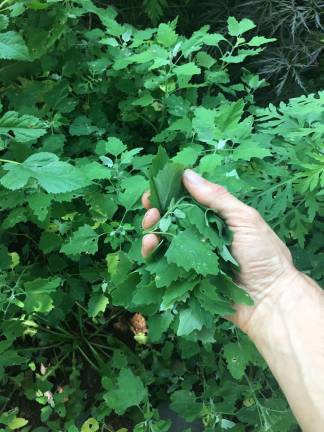Quinoa’s cousin is all over your yard

Lamb’s quarters is a forager’s dream: an excellent tasting, highly nutritious, and substantial green. If you come across a patch of these, you’ve found not only a heap of wild greens, but also a grain source loaded with fat, protein, and carbohydrates, a nutritional profile which is often hard to grow and forage. But with lamb’s quarters all you have to do is sit back and relax. An added bonus is that when you cook these wild greens, they hold their texture, not like spinach, which turns to mush.
Lamb’s quarters share the same genus as quinoa (Chenopodium), and gets its species name (alba) from the white cloudy sheen on the growing leaves. But although lamb’s quarters is the equivalent of quinoa both as a green and in terms of its nutritious seeds, for some reason, “somewhere over the rainbow syndrome” grips the western world, and we have been habituated to look non-locally.
It is little known that in South America, they eat quinoa greens on the regular. Meanwhile, in the U.S., farmers and gardeners struggle like anything to remove this valuable food and potential cash crop. As an experiment I once tracked how much I could harvest out of my friend’s farm at Cherry Valley Cooperative. From a 12-by-6-foot bed, I gathered 3.5 pounds in three hours. That kept me well fed for weeks of sautées, stirfries, and soups, as well as dehydrated greens for the winter.
Lamb’s quarters seed heads, when green, are edible and very nutritious, and can be steamed as they are before the plant starts to yellow and dry out. Once dry, the seeds are quinoa-like, but they are a little smaller and a bit hard to process without some basic grain winnowing equipment.
With any grain winnowing technique, there is a lot of finesse and some engineering skill involved. The seed heads must be dried, then rolled (traditionally in your hands), and then the chaff particles removed with the help of wind or other techniques. This last part may be done by tossing the grain in a winnowing tray, on a “windy enough” day, so that the chaff particles can fly off. The more that the chaff is broken down, the lighter it is in comparison with the seed, and therein lies the magic.
For lamb’s quarters, you can also use a sieve to extract the seeds out of the chaff. A little chaff is actually insoluble fiber, which serves the same function as Metamucil. So in the irony of mechanized grain production, it’s now so clean that we get the insoluble fiber. This is one of the benefits of hand winnowing without machines; you will only be able to get it “winnowed enough.” Dan De Lion